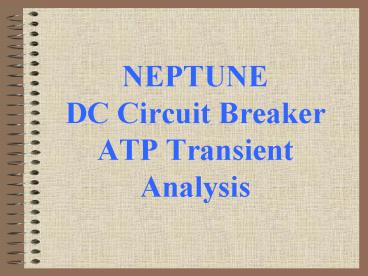NEPTUNE DC Circuit Breaker ATP Transient Analysis - PowerPoint PPT Presentation
1 / 16
Title:
NEPTUNE DC Circuit Breaker ATP Transient Analysis
Description:
Integration of logic circuit with the power circuit. SEQUENCE OF OPERATION ... of transient phenomena of electromagnetic as well as electromechanical nature. ... – PowerPoint PPT presentation
Number of Views:258
Avg rating:3.0/5.0
Title: NEPTUNE DC Circuit Breaker ATP Transient Analysis
1
NEPTUNEDC Circuit BreakerATP Transient Analysis
2
SCHEMATIC OF BREAKER CIRCUIT
3
STAGE 1
S2
S3
C
4
STAGE 2
S3
S2
5
STAGE 3
6
STAGE 4
7
STAGES
- Design of logic circuit
- Design of power circuit
- Integration of logic circuit with the power
circuit
8
SEQUENCE OF OPERATION
A B are control parameters S1 through S4 are
the switch status
9
SEQUENCE OF OPERATION
- It is a 2-input system
- Input A Gives indication of Fault.
- A 0 .. Normal operation.
- A 1 .. Break operation.
- Input B Gives indication that capacitor is
- fully charged when B changes from
0 to - 1.
10
TIMING DIAGRAM
11
LOGIC CIRCUIT
- The purpose of the logic circuit is to operate
the switches of the breaker circuit at
appropriate instants of time. - On indication of fault current, the logic circuit
is activated and operates the switches of the
breaker circuit over the entire sequence of break
and make.
12
LOGIC CIRCUIT
13
TRANSIENT ANALYSIS
- Task is Develop necessary Transient Models and
perform the Analysis. - Under certain circumstances such as short
circuit, transients will occur in the system. - This and other scenario need to be modeled so as
to perfect the system design, and to be able to
predict the effects of faults.
14
Alternate Transient Program
15
WHAT IS ATP?
- ATP is a universal program system for digital
simulation of transient phenomena of
electromagnetic as well as electromechanical
nature. - With this digital program, complex networks and
control systems of arbitrary structure can be
simulated. ATP has extensive modeling
capabilities and additional important features
besides the computation of transients.
16
Operating Principles of ATP
- Basically, trapezoidal rule of integration is
used to solve the differential equations of
system components in the time domain. - Non-zero initial conditions can be determined
either automatically by a steady-state, phasor
solution or they can be entered by the user for
simpler components. - Symmetric or unsymmetric disturbances are
allowed, such as faults, lightning surges, any
kind of switching operations including
commutation of valves.

